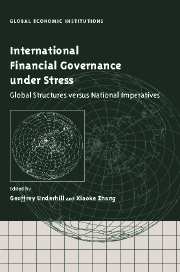Book contents
- Frontmatter
- Contents
- List of figures
- List of tables
- List of contributors
- Acknowledgements
- Introduction: global market integration, financial crises and policy imperatives
- I Financial globalisation and policy responses: concepts and arguments
- II Globalisation, financial crises and national experiences
- 5 Crisis consequences: lessons from Thailand
- 6 The politics of financial reform: recapitalising Indonesia's banks
- 7 South Korea and the Asian crisis: the impact of the democratic deficit and OECD accession
- 8 Currency crises in Russia and other transition economies
- 9 Capital account convertibility and the national interest: has India got it right?
- 10 Learning to live without the Plan: financial reform in China
- 11 The Asian financial crisis and Japanese policy reactions
- III Private interests, private–public interactions and financial policy
- IV Building the new financial architecture: norms, institutions and governance
- Conclusion: towards the good governance of the international financial system
- Index
9 - Capital account convertibility and the national interest: has India got it right?
Published online by Cambridge University Press: 22 September 2009
- Frontmatter
- Contents
- List of figures
- List of tables
- List of contributors
- Acknowledgements
- Introduction: global market integration, financial crises and policy imperatives
- I Financial globalisation and policy responses: concepts and arguments
- II Globalisation, financial crises and national experiences
- 5 Crisis consequences: lessons from Thailand
- 6 The politics of financial reform: recapitalising Indonesia's banks
- 7 South Korea and the Asian crisis: the impact of the democratic deficit and OECD accession
- 8 Currency crises in Russia and other transition economies
- 9 Capital account convertibility and the national interest: has India got it right?
- 10 Learning to live without the Plan: financial reform in China
- 11 The Asian financial crisis and Japanese policy reactions
- III Private interests, private–public interactions and financial policy
- IV Building the new financial architecture: norms, institutions and governance
- Conclusion: towards the good governance of the international financial system
- Index
Summary
One of the striking features of the Asian crisis is that some countries, including India, were largely unaffected by it and the contagion that followed. This chapter argues that capital account controls are critical in explaining India's stability, a conclusion that should reinforce the second thoughts that have begun to emerge as regards the desirability of capital account convertibility (CAC) as an integral element of the redesign of the international financial architecture. Section one of this chapter describes India's capital account controls and their place in the country's payments regime. Section two examines various episodes of balance-of-payments strain in the 1990s and the role played by capital controls in managing them. Section three analyses why India escaped the Asian crisis and contagion and highlights the importance of capital controls in this context. Section four discusses the political economy of India's resistance to the adoption of CAC. Section five considers the desirability of adopting CAC in India in the near future. Section six offers some concluding remarks.
India's payments regime: managed floating and capital controls
India's capital controls operate within the framework of a payments regime, inaugurated in March 1993, that is officially described as a ‘market determined unified exchange rate’. The de facto position is different. ‘Market determined’ should not be understood to mean a clean float. There is active, sometimes heavy, intervention by the Reserve Bank of India (RBI) in the foreign exchange market.
- Type
- Chapter
- Information
- International Financial Governance under StressGlobal Structures versus National Imperatives, pp. 182 - 202Publisher: Cambridge University PressPrint publication year: 2003
- 1
- Cited by



